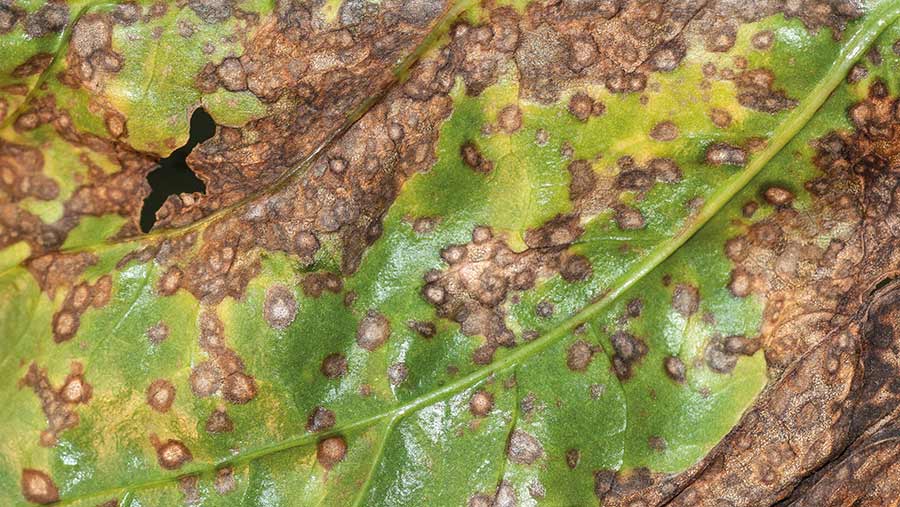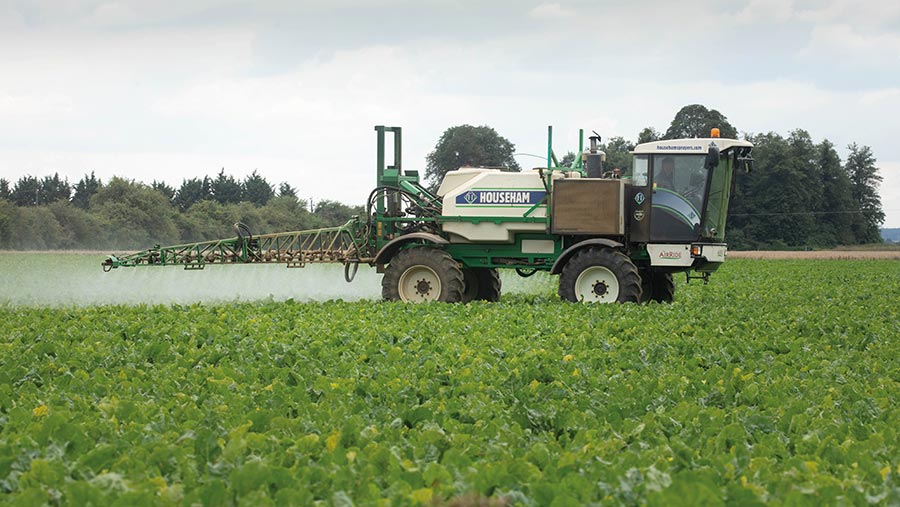Updated advice on tackling cercospora in sugar beet
 © Martyn Cox/Blackthorn Arable
© Martyn Cox/Blackthorn Arable Burying infected leaves, identifying disease early and timely fungicide treatments are all steps growers can make to keep on top of the aggressive sugar beet disease cercospora.
Cercospora is the top foliar disease in some parts of the world, like the US and Europe.
Until recently, the UK has been outside the temperature range that enables the disease to rapidly infect crops in summer. This has meant the disease has been limited to sporadic patches seen late in the season.
See also: Tips on managing nematodes without Vydate in sugar beet
But climate change means cercospora has, in the past five years, become economically damaging in British fields.
Losses are typically 25-30% of yield, but when combined with other diseases like beet yellows, it can be as high as 80%.
Although little was seen last year, British Beet Research Organisation (BBRO) head of knowledge exchange Simon Bowen points to 2020, which was a bad year for the disease and warns it’s likely to be seen more.
So how can farmers manage it in 2022? He says a good place to start is by understanding the disease lifecycle.
The disease overwinters on leaf trash. In early summer, spores are released and can infect developing crops given the right conditions.
High humidity and temperature sees germination of the spore and penetration of the leaf surface.
There are multiple infection cycles in a season.
Mr Bowen warns that if left unchecked, cercospora can result in aggressive loss of leaf in just two to four weeks. Only 5% loss of leaf is needed to become economically damaging.
Infected trash
One way to control the disease is by physically removing leaves from an infected crop.
Research shows that it takes more than 30 months for the risk from trash to reduce to a low level. However, the time taken can be reduced by burying the leaves.
Therefore, the advice for growers is to take the trash from badly infected fields and bury it, so it degrades more quickly. “This is not necessarily ploughing,” Mr Bowen adds.
He also warns that the spores can travel 100m, so consider neighbouring fields.
Better fungicide timing
Looking again at its lifecycle, temperature is a key factor with symptoms seen within five to 20 days of infection.
Fortunately, there is an existing prediction model developed in the US that predicts when conditions are ideal for the disease to develop, based on temperature and humidity data.
Last year, the BBRO launched a service that alerts farmers to look for the disease in their crops. If symptoms are found, farmers are advised to treat crops.
Mr Bowen recalls last year, in mid-July, there were amber alerts in many areas. By late July, the first confirmation of the disease was made through a plant clinic.
However, this was discovered when temperatures were high during the day, and humidity tended to be low. It was not until mid-September when red alerts were seen. A warm, wet autumn resulted in further symptoms.
He says the key lesson learned from last year was the need for timely fungicide applications and the importance of not letting the disease in by keeping the spray intervals to 21 days.

© Tim Scrivener
Last year’s key observations were:
- T1 – this was required mid-July in many crops. An azole/strobilurin mix like Escolta (cyproconazole + trifloxystrobin), Mirador Xtra (azoxystrobin + cyproconazole), Priori Gold/Angle (azoxystrobin + difenoconazole) worked well
- T2 – this was required early to mid-September. Crops were treated with azole/strobilurin two-spray programmes or straight azole in three-spray programmes
- T3 – an azole/strobilurin mix was needed in later-harvested crops, where disease activity remained.
Mr Bowen adds that the inclusion of copper in the tank mix seemed to help manage the disease.
Less successful was:
- T1 – cercospora not identified quickly enough and fungicide applied too late. This allowed the disease to progress
- T2 – the fungicide treatment interval was too long in late August/early September. The application interval needs to be 21 days where risk is high
- T3 – cercospora not being monitored and T3 not being applied in later-harvested crops.
Varietal susceptibility
BBRO has investigated varietal susceptibility to the disease in its monitoring plots, with the final assessment carried out in January 2022.
Differences were seen, and the varieties were grouped in the order of the amount of symptoms being spotted.
Keep crops healthy
The final advice is to keep crops healthy, avoid disease and crop nutrition stress. That’s because the disease tends to be more aggressive where crop health is compromised.
Mr Bowen says, for example, beet yellows infection was associated with higher cercospora infection levels.
“Although we saw little disease last year, we did see an effect of nutrient status. There was evidence of magnesium and potassium deficiency encouraging infection.”
Drought stress can also encourage severity, and crops grown in soil where farmyard manure was applied tended to have less cercospora.
Simon Bowen was speaking at the recent BBRO BeetTech event held at the Newark showground.
How to prevent cercospora
Plan
- Avoid short rotations
- Bury leaf residues
- Remove other potential sources of disease such as volunteers and spoil heaps
- Identify high-risk areas – for example, near previously infected fields
- Utilise variety susceptibility
- Monitor crops and use BBRO alert service (being repeated in 2022)
- Be flexible in fungicide programme
- Train staff on symptom identification
Protect
- Apply T1 fungicide at first symptoms
- Keep shorter interval to T2 where risk is high (14-21 days)
- Alternate actives
Perform
- Continue to monitor disease levels into autumn
- Check different varieties
- Monitor weather
- Assess need for T3 for late-harvested crops

